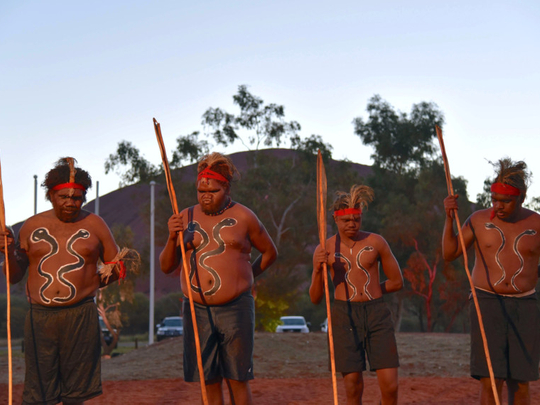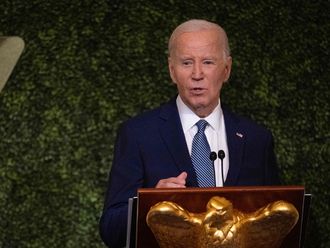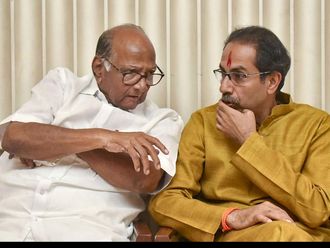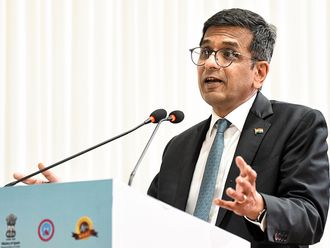
Time has long worked against Indigenous peoples. The English-speaking epochs of the last 200 years — the Pax Britannica and American Century — share the same dramatic opening scene: a global coup displacing millions of people and thousands of societies from the Mi’kmaq in New Foundland to the Mori in New Zealand.
Property, sovereignty and even history itself are said to originate with these Anglo-Saxon triumphs. History and time are appropriated as the sole possessions of the white men who inherited the earth. For the ruling class, their passage marks the steady advance of civilisation, modernity and progress. Rapturous booms and tumultuous busts are punctuated by bloody wars recast as heroic conquests. All throughout the land, alabaster monuments memorialise these triumphs and tragedies.
For Indigenous peoples, the same dates, statues and eras mark massacres, epidemics and expulsions. Generations rue the insidious devastation of occupation. Songs and stories reverberate to the rhythms and dreams of a halcyon freedom receding into legend as our last elders who bore witness pass onto the next world.
The history of the English-speaking world, brought crashing down upon Aboriginal peoples is a shared nightmare lurking in the collective subconscious of the survivors. From reservations, ghettoes and schools where the first peoples of these lands were sent to assimilate or die, we look out upon a world built on the premise that in it we have no place.
Nowhere is this history more palpable than Australia. The First Nations under the Southern Cross and the Emu in the Sky have called the Australian continent home for more than 60,000 years, making them one of the world’s longest-standing cultural groups with an unbroken connection to their ancestral lands.
Brutal onslaught
They endured one of colonisation’s most brutal onslaughts justified by settlers who openly questioned their humanity and often speculated that their diverse and vibrant societies were “the connecting link between man and the monkey tribe.”
In Australia, unlike the rest of the Commonwealth and the United States, treaties were never signed between First Nations and the Crown. Instead, the British — seasoned colonisers by this point in time — wrote off Aboriginal peoples as savage wanderers who did not have sufficient humanity to merit title to their homelands. The entire continent was expropriated under the doctrine of terra nullius — a legal principle that said Indigenous territories were empty and free for the taking.
Despite Australia’s relentless disavowal of Indigenous presence, Aboriginal peoples never gave up hope. A sign in front of the Aboriginal Tent Embassy established in 1972 on lawns facing Canberra parliament reads: Sovereignty never ceded. Through decades and even centuries of survival and struggle, the first Australians have won remarkable victories recognising their personhood, land rights and right to self-determination in the face of a profound history of dehumanisation.
Yet the stubborn and punitive Australian state continues to deny their rightful and enduring sovereignty.
Last week over 250 Aboriginal and Torres Strait Islander leaders gathered at the community of Mutitjulu situated at the eastern base of the sacred Uluru rock formation. There, in a community that still bears the scars of the controversial and punitive 2007 Northern Territory Intervention when soldiers invaded aboriginal communities, delegates worked long into the night to chart a path forward for aboriginal peoples in Australia. On Friday, in The Uluru Statement from the Heart, a majority rejected symbolic constitutional recognition and asserted their unextinguished sovereignty.
Sovereignty a ‘spiritual notion’
“This sovereignty is a spiritual notion: the ancestral tie between the land, or ‘mother nature’, and the Aboriginal and Torres Strait Islander peoples who were born therefrom, remain attached thereto, and must one day return thither to be united with our ancestors.” The statement continues, “This link is the basis of the ownership of the soil, or better, of sovereignty. It has never been ceded or extinguished, and coexists with the sovereignty of the Crown.”
The statement demands a permanent First Nations voice be enshrined in the constitution, perhaps in a model similar to New Zealand’s Mori seats or Section 35 of the Canadian Constitution, and calls for the formation of a commission for Makaratta — an Indigenous Yolgnu word for treaty.
While a great political fight lies ahead, the Uluru referendum and statement mark a historic moment — not just for Australia, but also for Indigenous peoples and the planet. After decades of struggle and advances won in small and often unnoticed increments, Indigenous sovereignty has arrived in full bloom as a global aspiration and force for human good.
It protects the lands, waters and natural resources that all living things require to survive. In December 2012, First Nations, Inuit and Metis peoples across Canada launched the ongoing Idle No More movement to protect the environment and assert Indigenous sovereignty.
In 2014, the Te Paparahi o Te Raki Inquiry of the Waitangi Tribunal in Aotearoa/New Zealand — a truth and justice-seeking commission founded in direct response to the 1970s Mori Renaissance — found that the Ngpuhi iwi, the largest tribe in New Zealand, never gave up their sovereignty.
Legal victory
This year, in a path-breaking Waitangi treaty settlement, the Whanganui iwi won a 140-year battle to recognise the legal personhood of their ancestral Whanganui River. And in the United States, an Indigenous coalition led by the Standing Rock Sioux spearheaded a captivating global movement to assert their Indigenous and treaty rights against the Dakota Access Pipeline.
The powerful and prayerful Indigenous demand for sovereignty in the name of water that gave birth to life and land that provides for people has encircled the world from Standing Rock to Uluru.
“The problem of the Twentieth Century is the problem of the colour line,” wrote WEB Du Bois in an address To the Nations of the World adopted by the 57 delegates attending the First Pan-African Conference in London in 1900. At Uluru and beyond, Indigenous peoples have insisted that the problems of the 21st Century will be the problems of sovereignty and the environment.
As the American superpower convulses in a self-inflicted crisis of greatness and greed, many, with good reason, have declared this the Chinese century. But in the wake of Standing Rock and Uluru, with rallying cries of Tino Rangatiratanga and Mni Wiconi, when we envision a planet that is left better rather than blighted for generations after us, this may also be the Indigenous century.
As humanity faces global crises of state and environment that demand new, creative and compassionate coalitions and ideas to rescue our planet and species from the precipice of disaster, the Indigenous century is just in time.
— Guardian News & Media Ltd
Julian Brave NoiseCat is an enrolled member of the Canim Lake Band Tsq’escen in British Columbia. He is a graduate of Columbia University and received a Clarendon Scholarship to study global and imperial history at the University of Oxford.








